
Shareholder Strategy
August 20, 2010
By Bill Tice
Facing the challenge of a collapsing kraft pulp industry in the Atlantic region and the resulting limited market for low-grade logs, an entrepreneurial group of woodlot owners has joined forces with other community residents to build a pellet plant.
Facing the challenge of a collapsing kraft pulp industry in the Atlantic region and the resulting limited market for low-grade logs, an entrepreneurial group of woodlot owners has joined forces with other community residents to build a pellet plant. The plant is located in the Nashwaak Valley in central New Brunswick, a pleasant 35-minute drive out of Fredericton on country roads. The enterprise, called Nashwaak Valley Wood Energy, hums along 24 hours/day, six days/week. It’s housed in an unassuming building that is situated in a forest clearing at the end of a long driveway near the community of Nashwaak Bridge.
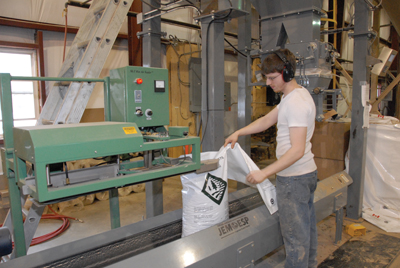 |
|
| Most product leaving Nashwaak Valley Wood Energy is sealed in 40-pound bags. Pictured here is Brandon Palmer working on the bagging line, which is equipped with a McT air sealer system and a JEM International scale. |
Ken Thomas, who is the manager of the 2 tonne/hour pellet plant, says that many of the investors and owners of the facility are local woodlot owners. “Having reached the conclusion that the loss of markets for lower grade wood was likely to be permanent, pellet manufacturing seemed to be an emerging alternative for their fibre,” he explains. “We provide an outlet for low-quality softwood pulpwood and also a market for species that traditionally did not have a home in our province, such as hemlock, tamarack, and pine pulpwood.”
Local Investment
But Thomas says it’s not just the woodlot owners who have embraced the plant, which produced its first pellets in the fall of 2009 following a construction process that took more than a year. “The community support for this project was very evident from the first meetings to discuss the project,” he says. “We had over 100 community members turn out during the early weeks of discussion, and most of them purchased some shares based on the plans that were presented. We now have 130 shareholders who have invested some capital in the project. Although some have a relatively small investment of a few hundred dollars, others have made a significant investment in the operation.”
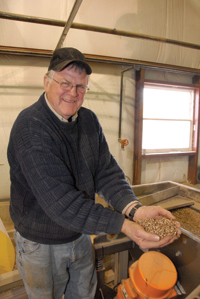 |
|
| Bill Hanson, who is a director and the self-professed troubleshooter at Nashwaak Valley Wood Energy, checks out some of the plant’s finished pellets before they enter the packaging line. |
Bill Hanson, who is a local woodlot owner and one of nine directors for the company, concurs with Thomas. “This is a local company that hires local people and puts money back into the local community,” says the retired Irving pulp mill maintenance foreman. Hanson is the self-professed troubleshooter at the plant, as he likes to solve the day-to-day technical issues that can occur in upstart operations like this one. “We raised about one-third of the funds needed to finance the almost $3 million operation from the local shareholders, and the rest came from loans through financial institutions,” he adds.
Hanson also credits local Conservative MLA Kirk MacDonald for initiating the process. “He wanted to help the community increase employment, so he did up an initial business plan and started looking for people in the area that could make up a diversified board, which we now have. That board includes a former Minister of Natural Resources, an entrepreneur, an insurance expert, a technical person, and our chair, Peter deMarsh, who has been actively involved in woodlot owner organizations at both the provincial and federal levels.”
Up and Running
With the funding in place, building permit approvals from the local authorities finalized, an approved environmental study, and an operating permit from the provincial Department of Environment in hand, deMarsh and his board contracted Pellet Systems International (PSI) of Nackawic, New Brunswick, to help them build the facility.
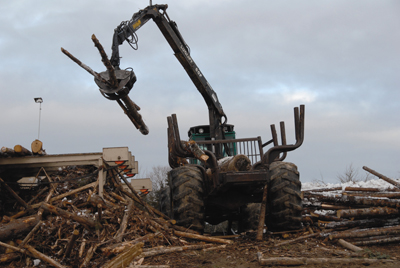 |
|
| A Timberjack 230A forwarder delivers logs from inventory to the pellet plant’s infeed. Most of the fibre for the mill comes from local woodlots.
|
“PSI was just a logical fit for us in terms of finding someone to work with,” Hanson says. “They are basically in our backyard, as Nackawic is just 45 minutes from Fredericton.”
In addition to supplying the plant’s pelletizer, Hanson says PSI sourced other equipment for the plant, providing a turnkey operation. Plant flow starts in the log yard, where self-loading log trucks deliver the fibre. The incoming logs are weighed with Avery Weigh-Tronix drive-on scales. Once in inventory, they are moved around the yard and to the log deck with a Volvo L90 front-end loader and a Timberjack 230A forwarder. From the log deck, the logs are processed through a Forano ring debarker that was purchased second hand and reconditioned, before being directed to a PSI-designed drum chipper. From there, the chips are gravity fed to an inclined conveyor belt that fills a surge bin that can hold enough chips to keep the plant running for up to six hours, depending on production speed.
Next in line is a cylinder rotary dryer from Independence, Kansas-based Earth Care Products Inc. Hanson says that one of the aspects he really likes about the dryer is that it is self-sufficient, as it is powered by an Earth Care furnace that runs on the plant’s own furnish. “The dryer is really efficient,” adds Hanson. “It makes eight passes and takes our chips from 45 to 60% moisture content down to 12 to 15% moisture content.”
Once the chips meet the required moisture content, they are sent to a Schutte Buffalo hammermill and then to an Earth Care meal bin, which is a silo with four auger screws for feeding the pelletizer. Hanson says that at this point, 10 to 15% of the product from the hammermill is redirected to the furnace while the balance goes to a PSI pelletizer that can produce 2 tonnes/hour of pellets. “We have tweaked it and squeezed a little more out of it if all is going well, but it is rated for 2 tonnes/hour,” notes Hanson with a sense of pride in the ability to maximize production.
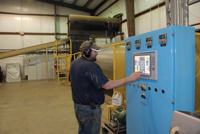 |
|
| Randy Urquhart, who is the main operator at the pellet plant, keeps an eye on things at the control panel for the Earth Care dryer.
|
A vacuum system with an outdoor bag house and two eight-inch lines pulls the finished pellets out of the pelletizer and into a silo, which is followed by a screening system to remove any unwanted fibre. A holding hopper and a metering hopper are then situated just above a bag line that features a McT air sealer system and a JEM International scale. Normally, the plant produces 40-pound bags of pellets. Any leftover air goes back to the bag house while fines and dust are reclaimed and directed back to the meal bin for recycling. Any residual hot air is used to heat the building, which is a 50 by 150-foot, 20 foot high, fully insulated, all-steel structure. Other major components at the plant include a Rockwell control system and a Spec Air dust collection system. For safety, the plant keeps a fire truck on site and has a number of fire extinguishers in key locations. They also have Hansentek spark detection systems installed by Spec Air and high-pressure water sprays installed by Viking Fire Protection at the bag house and dryer.
Start-up Curve
Like any start-up plant, the Nashwaak Valley facility has had its fair share of hiccups, says Thomas, but they are pleased with where they are today. “We have had our challenges with getting the different machinery components to work effectively together, and it took a while for our staff to understand and effectively use the equipment to its fullest, but we are getting there,” he explains. “With our fall start-up, we also had to deal with external circumstances in terms of markets, such as a very warm winter last year, early buying by consumers to avoid shortages experienced the previous year, and low oil prices driving energy costs down. These all added up to lower sales than we had anticipated, but on the positive side, those that have used our product are telling us that it is one of the best in the marketplace. Our order book for later this summer is looking very promising, and in addition, there seems to be a genuine move towards renewable forms of energy such as pellets.”
Markets
Hanson says the market for the company’s products is Atlantic Canada, mainly New Brunswick and Nova Scotia. “We sell a small amount of pellets to the local community as cash and carry, but most of our product is sold through a sales agent to distributors who supply retailers,” he explains. “Another market for our product is animal bedding, as they were using shavings from the sawmill industry,” he continues. “But with the slowdown in the forest industry and the shutting down of some mills, our grade 3 product has become a popular substitute, especially since it is a littler shorter and provides more surface contact than our number one grade product, which means it absorbs moisture quicker.
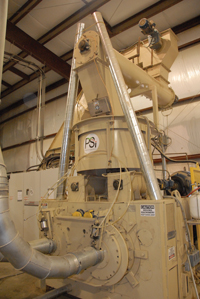 |
|
| Nashwaak Valley Wood Energy worked closely with Pellet Systems International (PSI), of Nackawic, New Brunswick, on equipment selection, including this PSI pelletizer that is rated for 2 tonnes/hour. |
As for the future, everyone at Nashwaak Valley Wood Energy is optimistic. “Although the plant was designed to produce 2 tonnes/hour, many of the components are able to do significantly more,” says Thomas. “Our intention is to expand to 5 tonnes/hour over the next couple of years, which is something we would have considered right from the beginning if we had been able to raise more share and loan capital.”
In talking with Thomas, it’s evident that he believes in the product and the benefits of using renewable energy. “Now is the time that we must really push all levels of government to promote and encourage this type of renewable energy,” he explains. “Our forests and abandoned farmlands could be used extensively for the production of energy crops. This type of energy could be considered to be renewable, sustainable, and locally produced, while offering a marketplace for our low-grade forest materials.”
Print this page